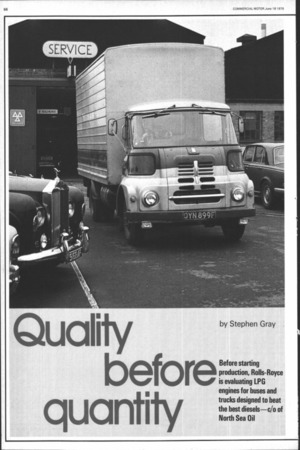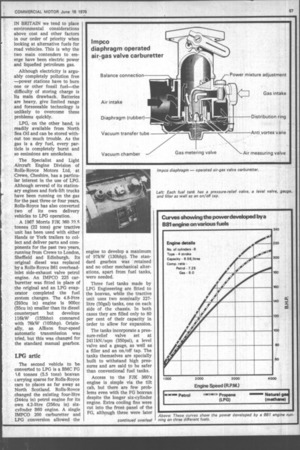Quality
Page 68

Page 69

Page 70

If you've noticed an error in this article please click here to report it so we can fix it.
before Before starting
production, Rolls-Royce
quanti
IN BRITAIN we tend to place environmental considerations above cost and other factors in our order of priority when looking at alternative fuels for road vehicles. This is why the two main contenders to emerge have been electric power and liquefied petroleum gas.
Although electricity is arguably completely pollution free —power stations have to burn one or other fossil fuel—the difficulty of storing charge is its main drawback. Batteries are heavy, give limited range and foreseeable technology is unlikely to overcome these problems quickly.
LPG, on the other hand, is readily available from North Sea Oil and can be stored without too much trouble. As the gas is a dry fuel, every particle is completely burnt and so emissions are smokeless.
The Specialist and Light Aircraft Engine Division of Rolls-Royce Motors Ltd, at Crewe, Cheshire, has a particular interest in the use of LPG. Although several of its stationary engines and fork-lift trucks have been running on the gas for the past three or four years, Rolls-Royce has also converted two of its own delivery vehicles to LPG operation.
A 1967 Morris FIX 360 77 s tonnes (22 tons) gcw tractive unit has been used with either Hands or York trailers to collect and deliver parts and components for the past two years, running from Crewe to London, Sheffield and Edinburgh. Its original diesel was replaced by a Rolls-Royce B61 overheadinlet side-exhaust valve petrol engine. An IMPCO 225 carburetter was fitted in place of the original and an LPG evaporator completed the fuel system changes. The 4.8-litre (293cu in) engine is 900cc (55cu in) smaller than its diesel counterpart but develops 116kW (155bhn) comnared with 78kW (I05bhp). Originally, an Allison four-speed automatic transmission was tried, but this was changed for the standard manual gearbox.
LPG artic
The second vehicle to be converted to LPG is a BMC FG i.6 tonnes (5.5 tons) boxvan carrying spares for Rolls-Royce cars to places as far away as North Scotland. Rolls-Royce changed the existing four-litre (244cu in) petrol engine for its own 4.2-litre (256cu in) sixcylinder B60 engine. A single IMPCO 200 carburetter and LPG conversion allowed the engine to develop a maximum of 97kW (130bhp). The standard gearbox was retained and no other mechanical alterations, apart from fuel tanks, were needed.
Three fuel tanks made by LPG Engineering are fitted to the boxvan, while the tractive unit uses two nominally 227litre (50gal) tanks, one on each side of the chassis. In both cases they are filled only to 80 per cent of their capacity in order to allow for expansion.
The tanks incorporate a pressure-relief valve set at 2411kN/sqm (350psi), a level valve and a gauge, as well as a filler and an on/off tap. The tanks themselves are specially built to withstand high pressures and are said to be safer than conventional fuel tanks.
Access to the FIX 360's engine is simple via the tilt cab, but there are few problems even with the FG boxvan despite the longer six-cylinder engine. Extra cooling fins were cut into the front panel of the FG, although these were later
continued overleaf
continued from page 67 found to be superfluous.
On the road, the most noticeable feature of the artic unit is its silence. Rolls-Royce delivery drivers prefer the conversion, especially as it is much quicker than similar diesel vehicles, even when fully laden.
Since the vehicles were converted, the boxvan has covered a total of 44,0631= (27,380 miles), recording a running total of 27.31it/100km (10.36mpg). The attic has travelled some 58,200km (36,162 miles) at 43.11it/100km (6.56mpg). During this time the number of breakdowns has been minimal.
Small diameter fuel pipes were fitted initially and these caused the gas to freeze. Servicing periods, says RollsRoyce, can be extended as the engine oil stays much cleaner, and if the times between tappet adjustments could be increased this period could be prolonged even more.
The two engines used by Rolls-Royce in its vehicles are versions of the long-established B-Series introduced in 1947, primarily for military use. Since then, 40,000 units have been produced.
Reliable
A measure of the reliability of gas-fuelled engines can be judged by a B81 (the eightcylinder R-R petrol engine) which is driving a compressor at the Rolls-Royce car factory, non-stop day and night. This particular engine has been running at high speed, fuelled by natural gas, for up to 2200 hours at a stretch. Although natural gas is not a suitable fuel for road vehicles (it's difficult to keep liquefied) it has similar characteristics and can be used as a comparison with LPG.
Rolls-Royce is using the vehicles it has converted as mobile test beds in order to prove the viability of LPG. Three main applications are envisaged for LPG — municipal; urban public service; and local distribution vehicles. All these categories of vehicle are obvious choices, covering relatively low mileages in towns or cities, where as conventional vehicles they would contribute to the pollution of the atmosphere.
However, no decision has been made by the DoE whether psvs running on LPG can qualify for the same fuel rebate as diesel vehicles. If they can, LPG becomes an attractive proposition.
Nevertheless, Rolls Royce has been working in conjunction with Cleveland Transit on the "Clean Air Bus," a converted Daimler Fleetline double-decker bus fitted with a B81 engine running on LPG. This has been operational for the past three years, with only one major breakdown when an oil pipe burst.
Municipal vehicles — refuse collection, road sweepers and so on — would again benefit the community by being quieter and cleaner in operation, and to date two councils are said to be expressing interest.
Distribution fleets carrying such commodities as bread and milk are the third type of vehicles Rolls-Royce considers suitable for LPG conversion. They operate over set routes, covering fairly low mileages at the sort of times when they could be a nuisance to local residents. A converted Leyland Clydesdale is going into service with the NFC delivering milk and dairy products from its base in the Perth area.
Rolls-Royce is jealous of its reputation for manufacturing quality products, so testing and evaluation will continue until all the "bugs" are eliminated. Nevertheless, R-R hopes that it will not be long before the more widespread use of LPG vehicles is adOpted.












































































































































































